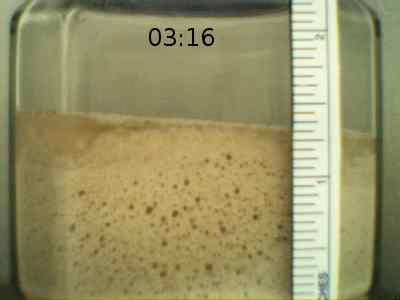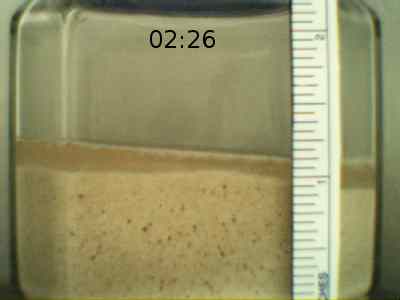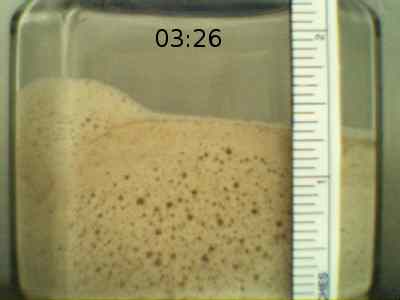By Curlydock
Ever wonder what your sourdough starter gets up to when you are not looking? I spied on mine with a web-cam for about a day. Now I know the shocking truth of its secret life and will show and tell all in this installment.
Why care
about this? There are several parallels between what happens when you feed your sourdough starter and what has happened on this very planet Earth when the human population began to explode.
In both cases, there is a population of living things in an environment that is limited in size and resources.
The sourdough starter is populated with yeast and bacteria in symbiosis. It needs flour for the population to grow and will consume it all if you do not replenish it. Then, there is a die off or crash in the population as a result of starvation, resource exhaustion and poisoning by the accumulation of waste material. Sound familiar?
Earth is populated with people, all the species that people depend upon, and many species relegated to “weed” category, thought of as expendable because we have not yet figured out how to exploit them. Ecologists and those who understand the need for organic farming methods are among the precious minority who value species diversity. As much as we like to think we can dominate nature, the real truth is that we are also symbiots. Our determination to dominate instead of live in harmony is driving the planet and all its populations into a dead-end.
The sourdough starter cannot grow out of it’s jar. (Well, it can but is not likely to find more flour if it does.) The human population cannot leave this planet in any significant numbers any time soon. (And, even if it does, how much organic coffee can we grow on the moon?)
Perhaps the sourdough starter can teach us something about mindless consumption and procreation. “But”, you may protest, “Unlike yeast, people have minds!” I will counter: “A person in a state of denial behaves automatically and just as if they do not have a mind.” Mindless consumers. Purchase what you don’t need. Throw the left-overs in the gutter. Make babies like the world was going out of style. Well, perhaps it is.
The sourdough starter needs flour. Unless you replenish it, the starter will consume all that is available.
The human population of Earth has developed a crippling dependance on oil and other limited resources. Even if we don’t run out of coal and oil, we cannot continue to use them because their use in this already over-populated planet is what is triggering global warming. So, discovering vast new supplies of cheap oil is no solution. In fact, it could aggravate the real problem. Irony.
Procedure
I mixed 54 g of flour with 103 g of water. To that I added 68 g of vigorous starter. Of that 225 g total mixture, I poured 122 g into a glass jar and loosely coverd with a plastic lid. The glass jar was placed in a temperature controlled chamber in front of a camera. The temperature was monitored and never significantly deviated from 79 deg. or 80 deg. F. For a period of about 12 hours, one picture was taken every 5 minutes, resulting in 150 images.
Results
I selected eight of the 150 images to put here. In each image, you will see that I have inserted a set of numbers at the top center. These numbers represent the duration, in hours and minutes, at the time the image was recorded. So, the first image is “00:00”:
The next image is after 2 hours and 26 minutes have elapsed:
At 02:26 you see the normal layer of “hooch” forming. I did not know until I did this experiment that it first forms at the top of the starter. You also see the bubbles of gas forming in the starter, causing the starter to “rise” as it would when used to leaven bread dough. The hooch and gas are the waste products from the yeast and bacteia, the populations of which are beginning to grow rapidly.
At 03:16 the starter has risen a good bit. The hooch layer is

getting pushed to one corner as the center bulges.
At 03:26 there is another unexpected phenomenon.
The corner where the hooch was is foaming violently. I say violently because this all took place on a time scale of 5 or10 minutes. This is after almost an hour and a half of liesurly, predictable rise in the starter volume and number of gas bubbles (correlate with population of micro-organisms). I watched this occure on the monitor, bemoaning the fact that all this excitement would be lost to posterity because I had decided to record only one image every 5 minutes. I would have needed a couple of images a second to capture all this short-term activity, which began suddenly and without warning and did not last long at all. I gripped the edge of my seat and practically left greasy nose-marks on my monitor, wondering what this portended for my little microbe-cosm.
At 03:46 the foam is leaving. Where did the hooch go?

If you look closely you can see the hooch is now all the way at the bottom of the jar.
At 06:26 you see you can’t keep good hooch down.
Now there are three distinct layers. Under the hooch is a layer of starter that seems to be inactive because there are no bubbles in it. You can’t see it in a few images, but I can tell you it was still very active. Small chunks and particles were seen both rising and falling in the hooch layer. Since the bottom layer was growing, it must be that more was falling than rising. Does this remind you of the economy and the extinction of the middle class?
At 07:01 you can see the first settling of the top layer.

This tells us that the yeast and bacteria are beginning to die off. They have used up their resource (flour) and are now starving and succumbing to the poisonous effects of their waste products. It looks like the peak occured a bit after six hours in this experiment.
At 14 hours and 30 minutes I ended the experiment.

The top layer is at its lowest level since its peak. Once it started falling, the fall was pretty monotonous. I could have let it run longer but it had been a long day and this felt very much like the end of history.
Conclusion
Can we take any macro lessons from this micro-biological model? There are some important differences. Our planet, unlike the starter jar that got only one charge of flour, is being re-charged daily with “free” energy from the sun.
The trouble is, we have not been living within the energy budget of the sun since technology allowed us to exploit oil and greed made it inevitable. The energy density of “black gold” cannot be matched by solar, wind, geothermal, etc. Nuclear has a waste problem and the likelihood of catastrophic accidents increases with time and the number of reactors in use.
We may be running out of time to reverse the toxic byproduct of burning fossil fuels: global warming. It may be too late. It could accelerate tenfold or more without warning (remember the foam and the inversion of the hooch layer happened catastrophically). Indeed, there may be evidence of such an acceleration now, see: “Global Warming Already Causing Extinctions, Scientists Say“, by Hannah Hoag for National Geographic News, Nov. 28, 2006.
These sudden accelerations and unpredictable changes can happen in non-linear systems that are under stress. A little push in a certain direction causes changes that themselves add to the push and you get exponential acceleration. The hooch layer suddenly inverts. The die-off caused by global warming or the loss of oil as an energy source could also happen more quickly than predicted by the most dire of doomsayers.
Here is a very good reference for those interested in reading more on the topic of ecosystems that experience overshoot and sudden extinction: “Overshoot in a Nutshell” by David M. Delany.



